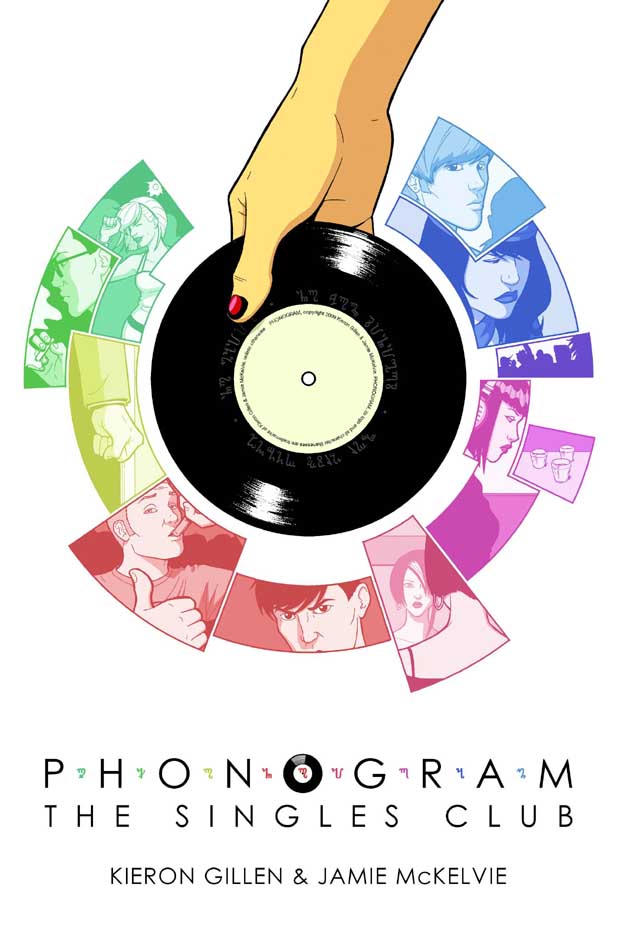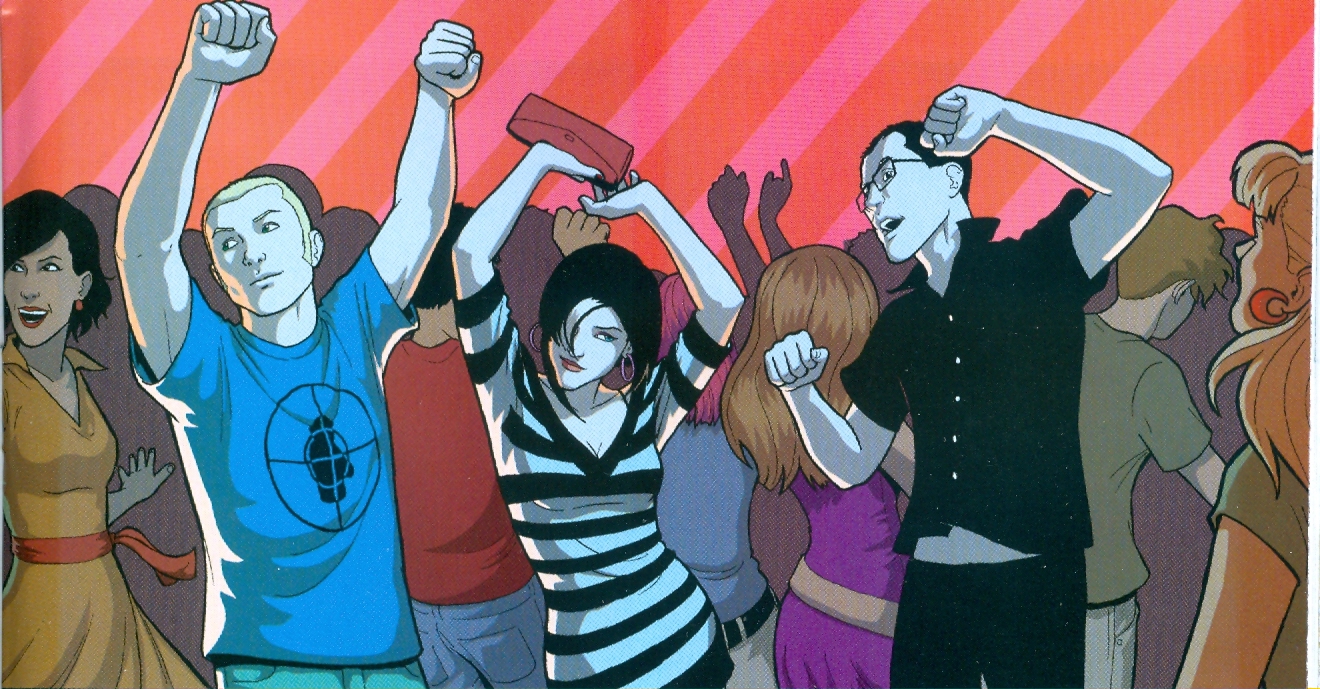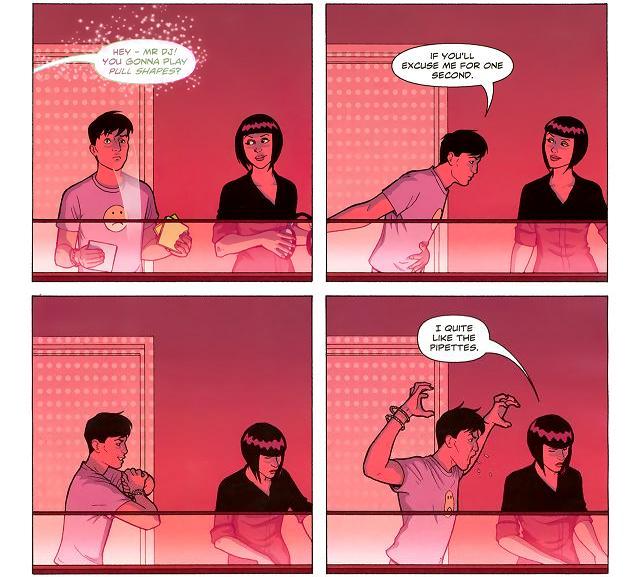 The first Phonogram book Rue Britannia was about music on a cerebral level as Kieron Gillen and Jamie McKelvie pulled us along on a whirlwind education, celebration and wake for Britpop. It was an almost impenetrable book at first, requiring the reader to possess the knowledge of a subset of pop music particular to Great Britain in the 1990s so that they could understand David Kohl’s hero journey. Somewhere in there though was the opening that you needed; it was about music but it wasn’t about Britpop. Britpop defined the context of Gillen and McKelvie’s story but the story, with only a minimal amount of tinkering, could apply to anything from rockabilly to grunge. The true defining aspect of Rue Britannia is about how we hold onto the things we love and how we eventually have to let them go. Most pop music belongs to a time and a place. Those things are static; our lives aren’t.
The first Phonogram book Rue Britannia was about music on a cerebral level as Kieron Gillen and Jamie McKelvie pulled us along on a whirlwind education, celebration and wake for Britpop. It was an almost impenetrable book at first, requiring the reader to possess the knowledge of a subset of pop music particular to Great Britain in the 1990s so that they could understand David Kohl’s hero journey. Somewhere in there though was the opening that you needed; it was about music but it wasn’t about Britpop. Britpop defined the context of Gillen and McKelvie’s story but the story, with only a minimal amount of tinkering, could apply to anything from rockabilly to grunge. The true defining aspect of Rue Britannia is about how we hold onto the things we love and how we eventually have to let them go. Most pop music belongs to a time and a place. Those things are static; our lives aren’t.
Their followup, Phonogram Volume 2: The Singles Club, is a very different book. Where Rue Britannia was ostentatious and epic, Gillen and McKelvie make The Singles Club much smaller and more intimate. The Singles Club is the comic equivalent of a night out with friends and acquaintances, catching up with them and even running into people that you just don’t want to see. Set just days before Christmas, 2006, there are only three rules that define the night for The Singles Club; no boy singers, you must dance and no magic. Rue Britania was epic; The Singles Club is surprisingly social.
In fact, forget about the magic. Gillen and McKelvie set up that rule as a guide more for the reader than for the characters in the book because the characters break it in almost every issue. It was easy to get lost in the “magic” of Rue Britannia, to get caught up in the endless Britpop references, sigils and musical incantations and miss what the story was really about. In The Singles Club, the magic is different; it’s not about the music but more about the experience of music. The magic of music in The Singles Club is about how it passes through you, how you experience it and what it does to you. In the pages of this book, music has the power to inspire people, to make them remember, to make them forget, to dream bigger than everyone else and to just plain have fun.
Visually, the biggest change to this second book is Matthew Wilson, the colorist. His bright and vibrant colors imbue a buzzing energy over Jamie McKelvie’s artwork. Through different effects, Wilson adds a rhythm and beat to this book that the first one was missing. It’s easy to get lost and swept up in the color, which visually acts as the substitute for the music in this book. The hues and tones suggest the tempos and licks of the music, affecting your feelings towards a scene the same way a hard guitar riff or a sweeping piano piece can change the way you experience a piece of music.
If Wilson supplies the music, McKelvie provides the dancing. Remember the rules, you must dance. The way the characters carry their own weight and shift from side to side tells so much about them. McKelvie knows how to cock a character’s head, hunch their shoulders, bite their lips or glare intently to get across just what they are feeling at that moment. So much of The Singles Club is about the character’s emotions in a particular moment, their pleasure and their pain, and McKelvie catches those emotions in simple, clean and expressive lines. Half of the time, it’s not what the characters are saying but how they’re saying it. That’s McKelvie’s great strength; he knows how to show what the characters are thinking and feeling.
In Gillen’s story (the lyrics to keep the metaphor going, I guess,) music becomes a social event. In the first book, David Kohl was on a very individualistic journey. The music mattered to him in very personal and specific ways. In your taste and appreciation of music, you were either with him or against him. With The Singles Club, Gillen allows us to experience the same night and the same music from seven different perspectives. He opens the book with Penny B., a character who is in every possible way the opposite of David Kohl. There’s not a disingenuous bone in Penny’s body; she exists in the moment and allows nothing to affect her for long. She moves along with the night, taking what it throws at her, whether it is a best friend who seems miles away or a boy she likes who shows no interest in her, and shrugs them off. The right song at the right moment takes her away from those problems and she never looks back.
The book moves along with many different characters, often doubling back on the same events but seen from a different point of view. Each chapter, except for one, circles around the characters and who they want to be for the night. They want to be the girl with the guy, the woman she is and not the girl she was, the guy who has all the brilliant ideas, the girl who wants the last name “Heaven” instead of “Evans,” the guy who just wants to have a good time, or the guy who would rather forget old loves. Gillen shows us that this night is about the here and now and not about the past or the future.
There are many characters but it’s the music that ties them all together. The middle chapter of The Singles Club focuses on Seth and Silent Girl, your DJs for the night. It’s their club and their rules. And it’s their chapter that reminds us about the magic of music, an incredible feat for an audio-less comic book. Focused mostly on their DJ booth, Gillen shows us how their direct the night, setting the music and the mood throughout the rest of the book. From their chapter, you can practically map out where all the other characters are during this night and how all of their paths intersect. The Singles Club is a giant ensemble story and this chapter ties together the fact that all of the stories are connected. It’s not an accident that Seth and Silent Girl’s chapter is in the middle of the book. It brings everything together and spins it all out for the end of the book. This is the chapter where Gillen and McKelvie get to make it purely about the movie and capture some of that old Rue Britannia elitism as Seth tries to make his will dominant on the night. He will not play “Pull Shapes,” no matter how much Penny B. bugs him to.
So, what do you do when the music stops? When Seth and Silent Girl start putting their equipment away and everyone else has already gone somewhere else before the lights come up? Sooner or later, everyone has to go home. The question is are they the same person they were when they started out or are they someone different? Have they become who they want to be? Phonogram: The Singles Club is a celebration of comics, of music, of a night with friends and of the discovery of who you can be when you hear just the right song.






Comments